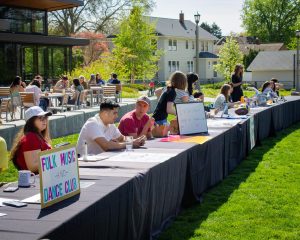
Sheehan Gallery’s second installment of the year, a contemporary and nontraditional exhibit titled “ReMapping: Expanding Landscape of Ceramics”, kicked off on Friday, Oct. 15 with a talk by contributing artist Casey McDonough. Incorporating non-traditional methods, materials, and inspiration, McDonough and other artists are bringing a new wave of ceramics to Whitman College.
Ceramics, according to curator and visiting professor of art Joe Page, is changing rapidly. ReMapping reflects those changes.
“The boundaries between different practices are being broken down,” Page said.
Exhibits at ReMapping incorporate electronics, new materials and viewer participation to create a novel gallery experience.
“It’s a survey of what’s being done in modern ceramics,” said Page. “These artists challenge the conventions and perceived limitations.”
Page met McDonough on Artaxis.org. McDonough contacted Page, asking him to do a show at Cedar Crest College in Pennsylvania. The two met in person at a ceramics convention in Phoenix, AZ, and Page flew out to Pennsylvania to do the show. Both shared an interest in nontraditional ceramics. McDonough, as well as six other artists, have come to Whitman to help put together ReMapping.
During his talk, McDonough whisked the audience through the bullet points of his background: his approach to ceramics, his past, his inspiration and his technique.
“I look at my own studio practice as a method of sorting through what I’ve been told is the truth,” McDonough explained. In order to create, he juxtaposes science and art.
“I went to college for marine biology,” McDonough continued. He flashed a number of short slides up on the screen: octopus eggs, transparent jellyfish and a transparent clump of cells.”I can use this information that I got from my science education to inform my artwork.”
McDonough cited the “ubiquitous forms” and “ubiquitous patterns” of the natural world. Some of the slides included cylindrical shapes of polyps rising up in clay and roughly-hewed bricks standing in a Fibonacci sequence.
According to Page, ceramics was at one point pigeonholed into a “manageable and marginalized spaced insulated from the trends . . . in contemporary art.”
The art form is traditionally associated with shapes and sculptures fired from clay or terracotta. ReMapping puts aside that assumption.
“What sets our work aside,” said McDonough, “is willingness to try new materials.”
Artist Claire Hedden explained that her work uses foam, cardboard and fabric to balance out dense, heavy materials like clay. Amy Santoferrano, another contributing artist, moves past physical ceramics completely by incorporating them stop-motion animation. Very little of ReMapping appears to have come out of a kiln.
Some of the other slides, as well as the ceramic pieces, included images of electron shells, balls of unfired clay lined with arching wire, food webs, flow charts and friend trees from MySpace and Facebook. The ceramics of Sheehan are linked together with delicate webs of string.
“Master Plan,” an installation set up by Gail Heidel, allows visitors to push around large terra-cotta bollards mounted on wheels.
“The viewer is invited to . . . create their own traffic pattern within the gallery,” Heidel wrote in her statement. “This invitation involves the viewer.”
Visitors can push the bollards around to arrange them as they like. The exhibit, rather than standing behind a sheet of glass or a barrier rope, is part of the visitor’s space.
McDonough also pushes the boundaries of participation and the dynamics between artist, exhibit and visitor. The bulbous green installations in his exhibit squeak and burble to engage the audience. When visitors pass in front of light-sensitive equipment mounted inside the ceramics, different electronic voices play. The opening patrons crowded around, testing the sculpture: moving their arms here and there, finding the sensor’s beam and cycling through the different voices.
“[These artists are] keeping one foot in the center while stretching out into the contemporary art world,” said Page.
Although it may not resemble a traditional ceramics exhibit, ReMapping provides visitors to Sheehan with work that intersects conventional ceramics and trends that define the art scene today. Joe Page will be presenting a curator’s talk in Olin on Saturday, Oct. 23 from 1-2 p.m. Sheehan Gallery is open from 9-5 during the week and 12-4 on weekends. The gallery exhibit will run until Nov. 17.









